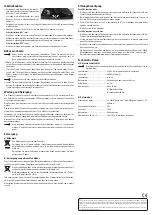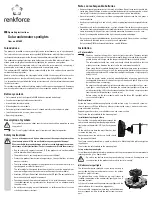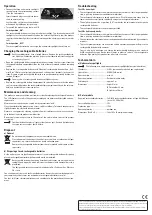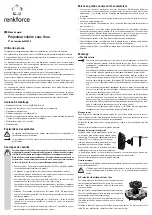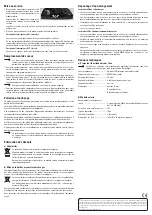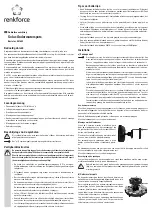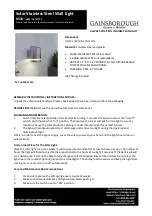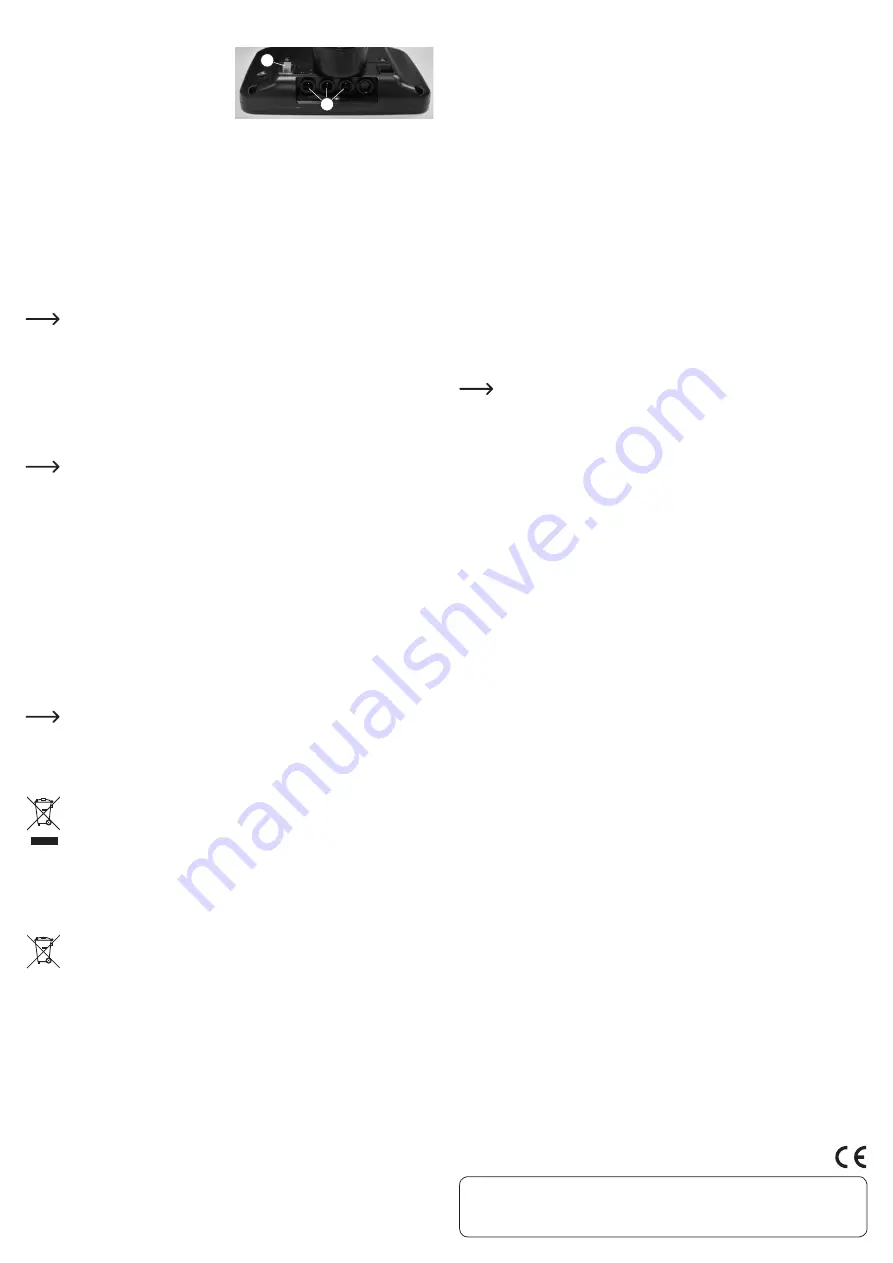
Operation
• Connect the three underwater spotlights‘
round plugs to the corresponding sockets
(1) on the solar module.
Insert the round plugs securely into the so-
ckets to ensure sealing.
Lay the cables so that they cannot be bent
or damaged by rubbing on sharp corners.
• Turn on/off the product using the switch (2).
Switch position „ON“:
The rechargeable batteries charge with sufficient sunlight. The three underwater LED
spotlights are activated automatically when the ambient light level is low (the product
registers the ambient light level via internal metering of the charging current to the solar
cell).
Switch position „OFF“:
The rechargeable batteries do not charge, the underwater spotlights do not turn on.
Changing the rechargeable batteries
Rechargeable batteries have a limited life span. Replace the rechargeable batte-
ries when the illumination period is only very short despite sufficient sunlight (or
at least every 2 years).
• Open the rechargeable battery compartment by unscrewing the four screws from the
rechargeable battery compartment lid on the back of the solar module and then removing
the lid.
• Replace the 3 rechargeable batteries with 5 identical rechargeable batteries (see „Tech
-
nical Data“). Observe correct polarity (po and negative/- terminals) during instal
-
lation. Dispose of used rechargeable batteries in an environmentally friendly fashion, see
section „Disposal“.
You may also use rechargeable batteries of higher capacity.
• Replace the rechargeable battery compartment lid correctly (make sure that the rubber
seal sits correctly between the rechargeable battery compartment lid and the solar mo-
dule) and tighten the four screws to fasten.
Maintenance and cleaning
The product is maintenance-free part from occasionally replacing the rechargeable battery.
The LED illuminants used in the underwater spotlights are permanently installed and non-
replaceable.
Maintenance or repairs may be carried out by a professional only.
Clean the exterior of the product using a clean, soft, dry cloth only. To remove tougher stains,
slightly dampen the cloth with lukewarm water.
Never use any aggressive cleaning agents or chemical solutions as they may cause dama-
ge to the housing or the product to malfunction.
Do not apply too much pressure to the cover of the solar module solar cell to prevent
scratching.
You should clean the solar cell cover at least once a year. Dust and dirt reduce the
charging current and thus light ON time.
Disposal
a) General
Do not dispose of the product with your household waste.
Please dispose of the device at the end of its service life in accordance with legal
regulations; e.g. return the device to a public collection point.
Remove the rechargeable batteries from the solar module and dispose of them
separately.
b) Disposing of used rechargeable batteries
As the end user, you are legally bound to return all used rechargeable batteries; disposing
of used rechargeable batteries with household waste is prohibited.
Rechargeable batteries containing hazardous substances are marked with the
symbol shown opposite, which indicates that disposal with household waste is
prohibited.
The designations for the heavy metals involved are: Cd = Cadmium, Hg = Mercury,
Pb = Lead.
You can dispose of your used rechargeable batteries free of charge at collection points in
your community, at our stores and everywhere rechargeable batteries are sold!
You thus fulfil your statutory obligations and contribute to the protection of the environ-
ment.
Troubleshooting
The LEDs do not light.
• The rechargeable batteries are empty (no sunlight on the solar cell for a longer period of
time, e.g. during bad weather conditions or wintertime).
• The rechargeable batteries are empty upon first use. Wait for one or two sunny days so
there is enough natural light to sufficiently charge the rechargeable batteries.
• The on/off switch must be at position „ON“ in order for the solar module to charge the
rechargeable batteries.
• The rechargeable batteries are not properly installed.
The LEDs light up only briefly.
• The rechargeable batteries are empty (no sunlight on the solar cell for a longer period of
time, e.g. during bad weather conditions or wintertime).
• Check whether the solar module is correctly positioned and not obstructed by any objects
or plants.
• The rechargeable batteries are exhausted and do not provide any power. Replace the
rechargeable batteries with new ones.
You can also try to discharge and charge the rechargeable batteries with a standard
NiMH round cell charging device several times in order to “refresh” the rechargeable
batteries. High quality charging devices offer such a function.
Technical data
a) Underwater spotlights
The following data apply to one underwater spotlight (delivery includes three).
Illuminants ................................................
6 LEDs (permanently installed, non-replaceable)
Light colour ..............................................
6500 K (Cold-white)
Operating time .........................................
max. 8 h
Operating location ..................................Outdoor in/under water
Cable length .............................................
approx. 3 m
Dimensions...............................................
height 61 mm
Ø Plate holder 89 mm
Ø Light base 50 mm
b) Solar module
Required rechargeable batteries .........
3x NiMH rechargeable batteries of type AA/Mignon
(each 1.2 V, 900 mAh)
Solar cell performance
..........................
1 W
Protection type
........................................
IP44
Operating location ..................................outdoor use
Dimensions (W x H x D)
.........................
146 x 105 x 28 mm (without clamp)
1
2
These operating instructions are a publication by Conrad Electronic SE, Klaus-Conrad-Str. 1, D-92240 Hirschau (www.conrad.com).
All rights including translation reserved. Reproduction by any method, e.g. photocopy, microfilming, or the capture in electronic data
processing systems require the prior written approval by the editor. Reprinting, also in part, is prohibited.
These operating instructions represent the technical status at the time of printing. Changes in technology and equipment reserved.
© Copyright 2014 by Conrad Electronic SE.


